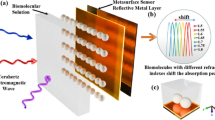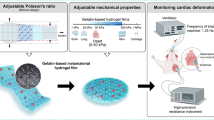Abstract
The spread of drug-resistant bacteria represents a growing worldwide health problem. The most efficient way to fight drug-resistant bacteria is to detect their colonies, identify their type, monitor their growth, and destroy them before they reach the human body. A gravimetric biomedical micro-electro-mechanical sensor (BioMEMS) system operating in the pico-gram range (10−12 g/cm2) has been proposed for detecting growth of drug-resistant bacterial colonies. The sensor is based on a MEMS metal-coated thin piezoelectric membrane resonator. A combination of shear horizontal surface acoustic (SHSAW), Bleustein-Gulyaev, skimming and ‘leaky’ waves, generated in the resonator, are highly sensitive to mass, density, viscoelastic, and electrochemical changes at the resonator/bacteria interface. Measuring resonant frequency shifts of the composite resonator provides information about the mass and type of the bacterium colony growing on the resonator.








Similar content being viewed by others
Notes
Q-factor is a measure of the rate at which a vibrating system dissipates its energy. A lower Q indicates a higher rate of energy dissipation.
S-parameters, or scattering parameters, are a set of parameters describing the scattering and reflection of traveling waves when a network is inserted into the resonator’s transmission line. S-parameters are normally measured as a function of frequency. S-parameters can be considered as the gain of the network and the subscripts denote the port numbers. The ratio of the output of port 2 to the incident wave on port 1 is designated S21.
References
Victorian Government’s Department of Human Services [online]. Available from URL: http://www.health.vic.gov.au [Accessed 2006 Oct 16]
Sauerbrey GZ. Verwendung von Schwingquarzen zur wãgung düimer schichten und zur mikrowagung. Z Phys 1959; 155: 206–22
Wohltjen H, Dessy R. Surface acoustic wave probe for chemical analysis. Anal Chem 1979; 51: 1458–75
Martin SJ, Frye GC, Cernosek RW, et al. Microtextured resonators for measuring liquid properties [abstract no. 229]. Presented at the 1994 Solid-State Sensor and Actuator Workshop; 1994 Jun 13–16; Hilton Head Island (SC)
Martin SJ, Frye GC, Senturia SD. Dynamics and response of polymer-coated surface acoustic wave devices: effects of viscoelastic properties and film resonance. Anal Chem 1994; 66: 2201–19
Ivanov D, Yelon A. Chemical sensitivity of the thickness-shear-mode quartz-resonator nanobalance. J Electrochem Soc 1996; 143: 2835–41
Ivanov D, Yelon A. Limits to the applicationof the quartz-crystal resonator as gravimetric instrument. In: Leddy J, Wightman RM, editors. New directions in electroanalytical chemistry: proceedings volume. Pennington (NJ): The Electrochemical Society, Inc., 1995: 110–9
Auld BA. Acoustic fields and waves in solids. New York: John Wiley and Sons, 1973
Dieulesaint E, Royer D. Elastic waves in solids: application to signal processing [in French]. Paris: Masson et Cie, 1974
Gulyaev YV. Review of shear surface acoustic waves in solids. IEEE T Ultrason Ferr 1998; 45: 935–8
Farneil GW, Adler EL. Elastic wave propagation in thin layers. In: Mason WP, Thurston RN, editors. Physical acoustics. Vol. IX. New York: Academic Press, 1972: 51
White RM, Wicher PJ, Wenzel SW, et al. Plate-mode ultrasonic oscillator sensors. IEEE T Ultrason Ferr 1987; 34(2): 162–71
Acknowledgments
No sources of funding were used to assist in the preparation of this review. The author has no conflicts of interest that are directly relevant to the content of this review.
Author information
Authors and Affiliations
Corresponding author
Rights and permissions
About this article
Cite this article
Ivanov, D. BioMEMS Sensor Systems for Bacterial Infection Detection. BioDrugs 20, 351–356 (2006). https://doi.org/10.2165/00063030-200620060-00005
Published:
Issue Date:
DOI: https://doi.org/10.2165/00063030-200620060-00005




